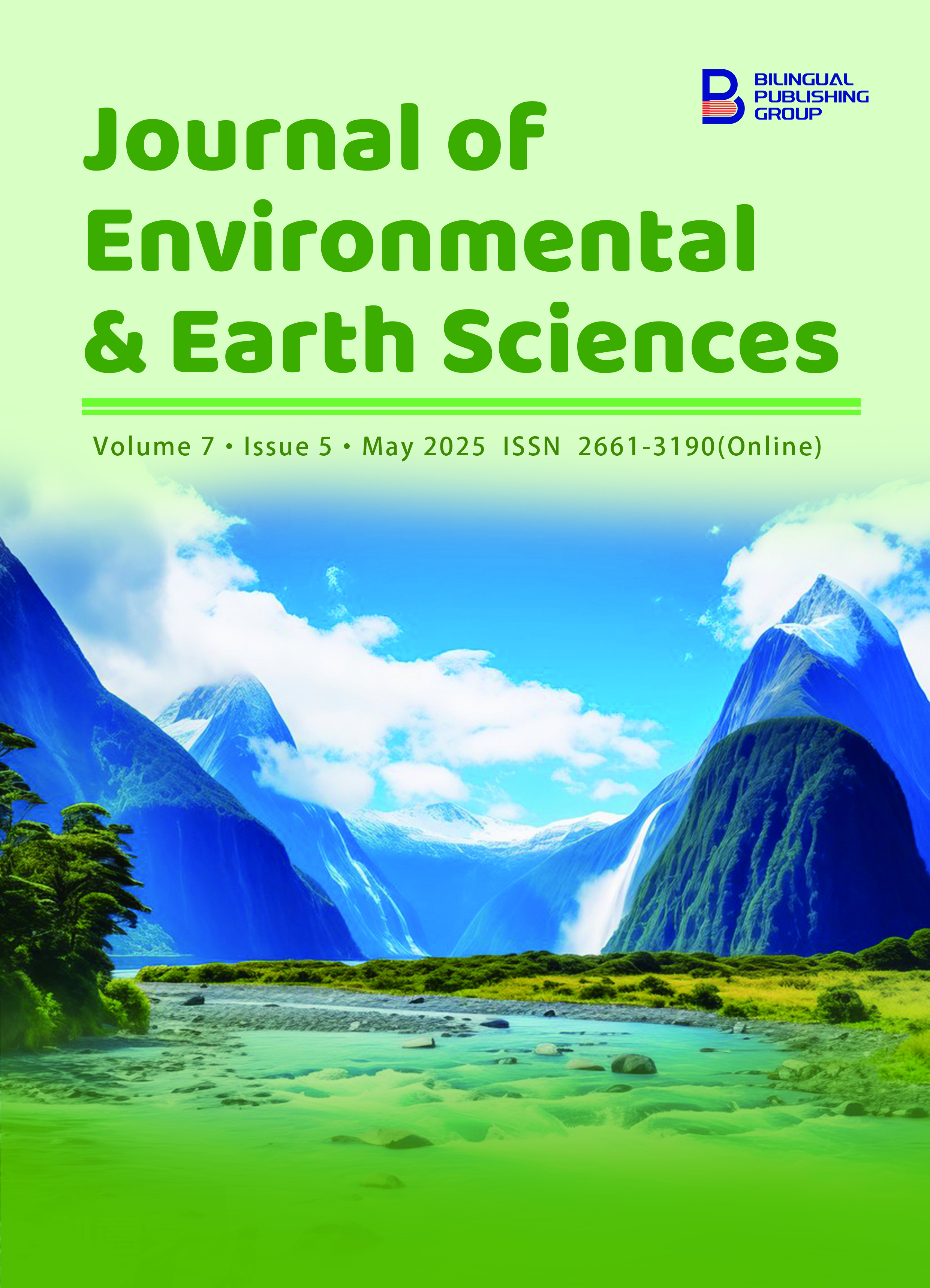
Hydrological Regime Variability between the Tien and Hau Rivers under the Impact of Anthropogenic Activities and Climate Change
DOI:
https://doi.org/10.30564/jees.v7i5.8707Abstract
The distribution of flow discharge between the Tien and Hau Rivers in the Vietnamese Mekong Delta (VMD) plays an important role in Vietnam’s agricultural and aquaculture production activities. However, recent variations in water levels and flow patterns, driven by both human activities and climate change (CC), have posed significant challenges for water resource management. This study evaluates the impacts of unsustainable exploitation and CC on the hydrological regime of the Tien and Hau Rivers using non-parametric statistical methods. Long-term water level data (1978–2023) from Tan Chau, Chau Doc, and Vam Nao observation stations were analyzed using the Mann-Kendall test (MK), Sen’s Slope (SS) estimator, and Pettitt’s test to detect trends, quantify change magnitudes, and identify abrupt shifts. The results indicate a significant decline in flood-season water levels, with annual decrease rates ranging from 41.5 to 72.9 mm in September and November. Conversely, a slight increasing trend in water levels was observed in the dry season (DS) during the studied time. Additionally, findings reveal that the upstream Tien River exerts greater control over the hydrological regime in the Vam Nao River. These insights contribute to disaster risk assessment, sustainable water resource planning, and ecological risk evaluation. Furthermore, the results contribute to providing a foundation for applying hydrological and hydraulic models to forecast hydrodynamics, thereby supporting effective water management strategies and mitigating flood and dry risks in the VMD.
Keywords:
Vietnamese Mekong Delta; Water Flow Distribution; Non-Parametric Tests; Upstream; Vam NaoReferences
[1] Binh, D.V., Kantoush, S., Mai, N.P., et al., 2018. Water level changes under increased regulated flows and degraded river in Vietnamese Mekong Delta. Journal of Japan Society of Civil Engineers, Ser. B1 (Hydraulic Engineering). 74(5), 871–876. DOI: https://doi.org/10.2208/jscejhe.74.5_I_871
[2] Duc, T.D., Halsema, G.V., Hellegers, P.J.G.J., et al., 2019. Long-term sustainability of the Vietnamese Mekong Delta in question: An economic assessment of water management alternatives. Agricultural Water Management. 223, 105703. DOI: https://doi.org/10.1016/j.agwat.2019.105703
[3] Anthony, E.J., Brunier, G., Besset, M., et al., 2015. Linking rapid erosion of the Mekong River delta to human activities. Scientific reports. 5(1), 14745. https://doi.org/10.1038/srep14745
[4] Kondolf, G.M., Rubin, Z.K., Minear, J.T., 2014. Dams on the Mekong: Cumulative sediment starvation. Water Resources Research. 50(6), 5158–5169. DOI: https://doi.org/10.1002/2013WR014651
[5] Lu, X.X., Siew, R.Y., 2006. Water discharge and sediment flux changes over the past decades in the Lower Mekong River: possible impacts of the Chinese dams. Hydrology and Earth System Sciences. 10(2), 181–195. DOI: https://doi.org/10.5194/hess-18-3033-2014
[6] Hackney, C.R., Darby, S.E., Parsons, D.R., et al., 2020. River bank instability from unsustainable sand mining in the lower Mekong River. Nature Sustainability. 3(3), 217–225. DOI: https://doi.org/10.1038/s41893-019-0455-3
[7] Binh, D.V., Kantoush, S., Sumi, T., 2020. Changes to long-term discharge and sediment loads in the Vietnamese Mekong Delta caused by upstream dams. Geomorphology. 353, 107011. DOI: https://doi.org/10.1016/j.geomorph.2019.107011
[8] Gierszewski, P.J., Habel, M., Szmańda, J., et al., 2020. Evaluating effects of dam operation on flow regimes and riverbed adaptation to those changes. Science of the Total Environment. 710, 136202. DOI: https://doi.org/10.1016/j.scitotenv.2019.136202
[9] Mai, N.P., Kantoush, S., Sumi, T., et al., 2018. Assessing and adapting the impacts of dams operation and sea level rising on saltwater intrusions into the Vietnamese Mekong Delta. Journal of Japan Society of Civil Engineers, Ser. B1 (Hydraulic Engineering). 74(5), 373–378. DOI: https://doi.org/10.2208/jscejhe.74.5_I_373
[10] Hoang, L.P., Vliet, M.T.H.v., Kummu, M., et al., 2019. The Mekong’s future flows under multiple drivers: How climate change, hydropower developments and irrigation expansions drive hydrological changes. Science of the Total Environment. 649, 601–609. DOI: https://doi.org/10.1016/j.scitotenv.2018.08.160
[11] Kim, T.T., Huong, N.T.M., Huy, N.D.Q., et al., 2020. Assessment of the impact of sand mining on bottom morphology in the Mekong River in an Giang Province, Vietnam, using a hydro-morphological model with GPU computing. Water. 12(10), 2912. DOI: https://doi.org/10.3390/w12102912
[12] Lu, X.X., Chua, S.D.X., 2021. River discharge and water level changes in the Mekong River: Droughts in an era of megadams. Hydrological Processes. 35(7), e14265. DOI: https://doi.org/10.1002/hyp.14265
[13] Yun, X., Tang, Q., Wang, J., et al., 2020. Impacts of climate change and reservoir operation on streamflow and flood characteristics in the Lancang-Mekong River Basin. Journal of Hydrology. 590, 125472. DOI: https://doi.org/10.1016/j.jhydrol.2020.125472
[14] Anh, L.H., Thong, N., Gratiot, N., et al., 2023. The multi-channel system of the Vietnamese Mekong Delta: Impacts on the flow dynamics under relative sea-level rise scenarios. Water. 15(20), 3597. DOI: https://doi.org/10.3390/w15203597
[15] Minh, H.V.T., Nam, N.D.G., Ngan, N.V.C., et al., 2024. Is Vietnam’s Mekong Delta facing wet season droughts?. Earth Systems Environment. 1–33. DOI: https://doi.org/10.1007/s41748-024-00472-3
[16] Park, E., Loc, H.H., Binh, D.V., et al., 2022. The worst 2020 saline water intrusion disaster of the past century in the Mekong Delta: Impacts, causes, and management implications. Ambio. 51(3), 691–699. DOI: https://doi.org/10.1007/s13280-021-01577-z
[17] Eslami, S., Hoekstra, P., Nam, N.T., et al., 2019. Tidal amplification and salt intrusion in the Mekong Delta driven by anthropogenic sediment starvation. Scientific reports. 9(1), 18746. DOI: https://doi.org/10.1038/s41598-019-55018-9
[18] Binh, D.V., Kantoush, S.A., Saber, M., et al., 2020. Long-term alterations of flow regimes of the Mekong River and adaptation strategies for the Vietnamese Mekong Delta. Journal of Hydrology: Regional Studies. 32, 100742. DOI: https://doi.org/10.1016/j.ejrh.2020.100742
[19] Fujihara, Y., Hoshikawa, K., Fujii, H., et al., 2016. Analysis and attribution of trends in water levels in the Vietnamese Mekong Delta. Hydrological processes. 30(6), 835–845. DOI: https://doi.org/10.1002/hyp.10642
[20] Lee, S.K., An, D.T., 2019. Spatio-temporal variations in meteorology drought over the Mekong River Delta of Vietnam in the recent decades. Paddy and Water Environment. 17, 35–44. DOI: https://doi.org/10.1007/s10333-018-0681-8
[21] Jordan, C., Tiede, J., Lojek, O., et al., 2019. Sand mining in the Mekong Delta revisited-current scales of local sediment deficits. Scientific reports. 9(1), 17823. DOI: https://doi.org/10.1038/s41598-019-53804-z
[22] Brunier, G., Anthony, E.J., Goichot, M., et al., 2014. Recent morphological changes in the Mekong and Bassac river channels, Mekong delta: The marked impact of river-bed mining and implications for delta destabilisation. Geomorphology. 224, 177–191. DOI: https://doi.org/10.1016/j.geomorph.2014.07.009
[23] Xue, Z., Liu, J.P., Ge, Q., 2011. Changes in hydrology and sediment delivery of the Mekong River in the last 50 years: Connection to damming, monsoon, and ENSO. Earth Surface Processes and Landforms. 36(3), 296–308. DOI: https://doi.org/10.1002/esp.2036
[24] Thanh, N.C., An, D.T., 2024. Assessing water level variability in the Mekong Delta under the impacts of anthropogenic and climatic factors. Journal of Environmental & Earth Sciences. 7(1), 123–131. DOI: https://doi.org/10.30564/jees.v7i1.7355
[25] Yoshida, Y., Lee, H.S., Trung, B.H., et al., 2020. Impacts of mainstream hydropower dams on fisheries and agriculture in lower Mekong Basin. Sustainability. 12(6), 2408. DOI: https://doi.org/10.3390/su12062408
[26] Urban, F., Nordensvärd, J., Khatri, D., et al., 2013. An analysis of China’s investment in the hydropower sector in the Greater Mekong Sub-Region. Environment, Development Sustainability. 15, 301–324. DOI: https://doi.org/10.1007/s10668-012-9415-z
[27] Bao, J., Twardek, W.M., Zhang, C., et al., 2023. Mitigating the cumulative effects of hydropower and climate change on riverine fishes. Reviews in Fish Biology Fisheries. 33(4), 915–930. DOI: https://doi.org/10.1007/s11160-023-09766-7
[28] Cho, M.S., Qi, J., 2023. Characterization of the impacts of hydro-dams on wetland inundations in Southeast Asia. Science of the Total Environment. 864, 160941. DOI: https://doi.org/10.1016/j.scitotenv.2022.160941
[29] Anh, T.T., Pittock, J., Duc, T.D., 2020. Adaptive flood governance in the Vietnamese Mekong Delta: A policy innovation of the North Vam Nao scheme, An Giang Province. Environmental Science Policy. 108, 45–55. DOI: https://doi.org/10.1016/j.envsci.2020.03.004
[30] Binh, D.V., Kantoush, S.A., Sumi, T., et al., 2021. Effects of riverbed incision on the hydrology of the Vietnamese Mekong Delta. Hydrological Processes. 35(2), e14030. DOI: https://doi.org/10.1002/hyp.14030
[31] Li, D., Long, D., Zhao, J., et al., 2017. Observed changes in flow regimes in the Mekong River basin. Journal of Hydrology. 551, 217–232. DOI: https://doi.org/10.1016/j.jhydrol.2017.05.061
[32] Winemiller, K.O., McIntyre, P.B., Castello, L., et al., 2016. Balancing hydropower and biodiversity in the Amazon, Congo, and Mekong. Science. 351, 128–129. DOI: https://doi.org/10.1126/science.aac7082
[33] Sun, H., He, D., Sui, X., et al., 2020. Predicting impacts of future climate change and hydropower development towards habitats of native and non-native fishes. Science of the Total Environment. 707, 135419. DOI: https://doi.org/10.1016/j.scitotenv.2019.135419
[34] Binh, D.V., Kantoush, S.A., Ata, R., et al., 2022. Hydrodynamics, sediment transport, and morphodynamics in the Vietnamese Mekong Delta: Field study and numerical modelling. Geomorphology. 413, 108368. DOI: https://doi.org/10.1016/j.geomorph.2022.108368
[35] Lee, S.K., An, D.T., 2020. Extreme rainfall trends over the Mekong Delta under the impacts of climate change. International Journal of Climate Change Strategies and Management. 12(5), 639–652. DOI: https://doi.org/10.1108/IJCCSM-04-2020-0032
[36] Khuong, T.H., Menenti, M., Jia, L., 2022. Surface water mapping and flood monitoring in the Mekong Delta using sentinel-1 SAR time series and Otsu threshold. Remote Sensing. 14(22), 5721. DOI: https://doi.org/10.3390/rs14225721
[37] Pettitt, A.N., 1979. A non‐parametric approach to the change‐point problem. Journal of the Royal Statistical Society: Series C (Applied Statistics). 28(2), 126–135. DOI: https://doi.org/10.2307/2346729
[38] Yue, S., Pilon, P., Cavadias, G., 2002. Power of the Mann–Kendall and Spearman’s rho tests for detecting monotonic trends in hydrological series. Journal of Hydrology. 259(1–4), 254–271. DOI: https://doi.org/10.1016/S0022-1694(01)00594-7
[39] Wang, F., Shao, W., Yu, H., et al., 2020. Re-evaluation of the power of the Mann-Kendall test for detecting monotonic trends in hydrometeorological time series. Frontiers in Earth Science. 8(14), 1–12. DOI: https://doi.org/10.3389/feart.2020.00014
[40] Coen, M.C., Andrews, E., Bigi, A., et al., 2020. Effects of the prewhitening method, the time granularity, and the time segmentation on the Mann–Kendall trend detection and the associated Sen’s slope. Atmospheric measurement techniques. 13(12), 6945–6964. DOI: https://doi.org/10.5194/amt-13-6945-2020
[41] Meena, M., 2020. Rainfall statistical trend and variability detection using Mann-Kendall test, Sen’s slope and coefficient of variance—A case study of Udaipur district (1957–2016). Applied Ecology and Environmental Sciences. 8(1), 34–37. DOI: https://doi.org/110.12691/aees-8-1-5
[42] Kendall, M., 2015. Trend analysis of Pahang river using non-parametric analysis: Mann Kendall’s trend test. Malaysian Journal of Analytical Sciences. 19(6), 1327–1334.
[43] Sen, P.K., 1968. Estimates of the regression coefficient based on Kendall’s tau. Journal of the American Statistical Association. 63(324), 1379–1389. DOI: https://doi.org/10.1080/01621459.1968.10480934
[44] Aswad, F.K., Yousif, A.A., Ibrahim, S.A., 2020. Trend analysis using Mann-Kendall and Sen’s slope estimator test for annual and monthly rainfall for Sinjar district, Iraq. Journal of Duhok University. 23(2), 501–508.
[45] Şen, Z., 2012. Innovative Trend Analysis Methodology. Journal of Hydrologic Engineering. 17(9), 1042–1046. DOI: https://doi.org/10.1061/(ASCE)HE.1943-5584.0000556
Downloads
How to Cite
Issue
Article Type
License
Copyright © 2025 Nguyen Dam Quoc Huy, Tran Thi Kim, Dang Truong An

This is an open access article under the Creative Commons Attribution-NonCommercial 4.0 International (CC BY-NC 4.0) License.







 Nguyen Dam Quoc Huy
Nguyen Dam Quoc Huy






